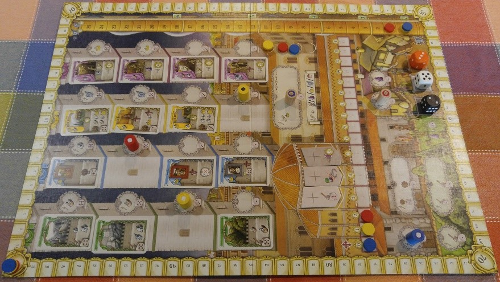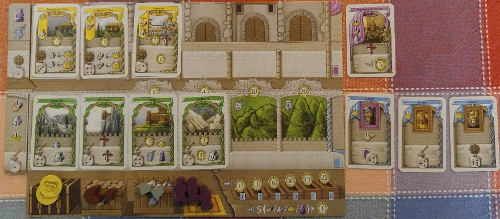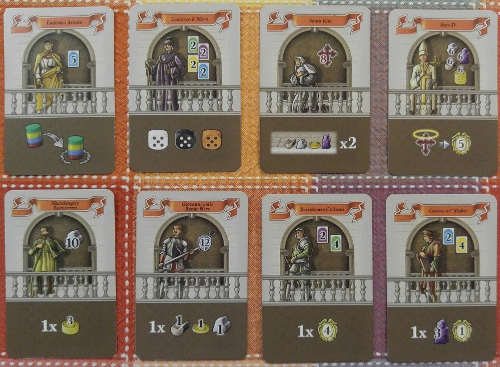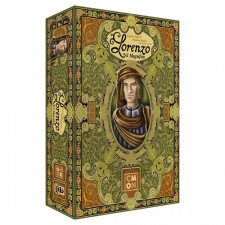Lorenzo il Magnifico Review
on Jul 26, 2017
On the surface, Lorenzo il Magnifico is unremarkable. It's got a drab green cover with a Renaissance guy frowning. When you unfold the board and set everything up, there are multiple tracks, a number of different cards, and iconography everywhere. Despite all these things that you’ve seen before, as the game starts to whir, you realize that Lorenzo il Magnifico is not “just another soulless Euroâ€. It’s a game that is far greater than the sum of its parts, thanks, in part, to three oversized, wooden dice.

Dice placement without the dice placement.
In most dice placement games, players each have their own pool of dice that they roll and place on spaces to take actions. Although there are usually ways to mitigate bad rolls, it can often be the case that one player simply lucks out over another. Lorenzo il Magnifico isn’t having any of this. Instead, all players have to deal with the same dice. Whaaat? How has nobody thought of this before now?
The three dice are rolled at the beginning of each round. The value of these dice determines the value of your corresponding colored family member for the round. For example, the orange die is a 3, so your orange-die family member can go on any spot with a value of 3 or less. That fateful toss at the beginning of each round has players hollering for a good roll like they’re at a Craps table in Vegas. Though lower valued dice are worse since they limit what actions you can perform, there are ways to work around this, even if the roll comes up snake eyes. For one, there are always spots that you can go on that require just a 1. Second, given that you’re an Italian noble, you have servants that you can spend to boost a family member’s value. There are also cards that can alter the value of a particular family member or action. These cards, along with others in the game, serve as the yin to the dice’s yang.

Italy: birthplace of a cultural movement… and victory points.
Cards come in four flavors: territories gain you resources, buildings that let you convert those resources, characters to give you permanent bonuses/effects, and ventures that give you end game victory points. Many cards have an immediate effect when you gain it, which can help you earn that extra dollar or piece of wood you need on a future turn. Of course, you’ve seen all this before, so you know that finding the best combination of these is the key to victory. However, it’s the interaction between the dice rolled every round, your own tableau, and the scant availability of spaces to place on during a round that makes Lorenzo il Magnifico stand out among the many other drab, frowny box cover games. As you vie against your opponents for the right card at the right time, the tension (and, often, desperation) becomes palpable. As though balancing resources and actions aren’t enough, the military and faith tracks remind you that you have a few more plates to keep spinning.
The military track might as well have been called Puppies & Rainbows, or anything else really, as it has nothing to do with aggression. It functions as an additional currency or threshold for purchasing cards or adding them to your tableau. The faith track is a little more thematic as it represents how much support you show for the church, which is a mini event that will happen every two rounds. If you can’t or choose not to show support, you are excommunicated, meaning you have a penalty for the rest of the game. Sometimes, the penalties don’t affect what you’re doing, so you can ignore it for a round. You can’t really disregard it the whole game though. Paying for an additional servant while boosting your family member’s value is rough. Not getting to place your worker until everyone else has placed is even rougher.
Altogether, these different parts of the game weave together seamlessly. Though no part of the game is outright ignorable, Lorenzo isn’t asking you to do everything. Instead, you’re deciding how you’re going to build your engine and hoping that it’s more of a Mustang than a Pinto. You can clearly carve your own path and one of the things that aids this immensely is by playing with the “advanced rules,†also known as “the only way to play the gameâ€. With slightly different starting boards and a handful of leaders, these additional elements give you some direction in the game without beholding you to it. Leaders offer you ongoing or once-per-round bonuses that are all awesome. However, you probably won’t be able to meet the criteria for most of the leaders, which is fine because you can ditch them for resources or moving up the military or faith track when you need to. And you will need to. No matter what player count you’re dealing with, the game is always tense and you’ll always need just one more of something.

Drafting Renaissance leaders is my version of fantasy football.
On their own, none of the things in Lorenzo il Magnifico are particularly new, different, or even innovative. But the game comes together in a way that lets you specialize and combo and feel satisfied with what you’ve set up. I love when games let me do this. So, if I have to deal with another Renaissance setting where I’m a noble trying to earn the most prestige and fame, at least it’s a game that’s as well thought out as Lorenzo il Magnifico.

 Customer Support
Customer Support  Subscribe
Subscribe 




 Account
Account  Wishlist
Wishlist 

